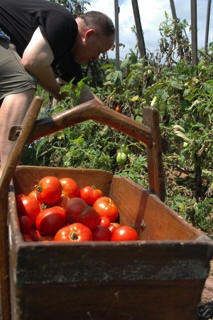(9/5) I can boast that over this Labor Day weekend, I attended a party where I both saw and ate part of an heirloom tomato that weighed in at 1.87 pounds. This, of course, projected me outside to search for the garden that produced such a delicacy. The raised beds were tidy, but the tomatoes, like mine, looked weathered and tired. Fungal diseases had taken their toll.
One canít spend time with plants without bearing witness to the interplay of soil, climate, weather, insects, and diseases. This year, the cool wet weather gave a great advantage to fungal diseases that affect tomatoes. Early blight, septoria leaf spot, and late blight reduced the health and productivity of many gardenersí tomatoes this summer, mine included.
I mention this only as a point of interest. Your hair should not be spontaneously igniting on fire at this time. Both early blight and septoria leaf spot are common in Maryland and relatively benign for the home gardener. Symptoms usually show up on the oldest leaves first because rain splashes spores that have overwintered in the soil and on plant debris.
 Despite its name, early blight can show up anytime during the growing season. It causes lesions on the leaves that quickly enlarge and sometimes spread to stems and fruits. Heavy dew, rain, and moderate temperatures increase the spread of the disease. Although it weakened my Romas, the plants still produced
plenty of tomatoes for multiple batches of tomato sauce for the pantry.
Despite its name, early blight can show up anytime during the growing season. It causes lesions on the leaves that quickly enlarge and sometimes spread to stems and fruits. Heavy dew, rain, and moderate temperatures increase the spread of the disease. Although it weakened my Romas, the plants still produced
plenty of tomatoes for multiple batches of tomato sauce for the pantry.
Septoria leaf spot is another fungal disease that is very common. Small circular lesions form on the lowest leaves first. Although it can spread up the plant, it doesnít affect stems or fruit. I am not a commercial producer so a little septoria doesnít give me a momentís pause, despite its ominous sounding latin name.
Lastly, there is late blight. This is a disease that causes significantly more damage and can kill entire tomato plants. Damage appears as dark, water soaked spots on leaves and stems. The lesions enlarge and can kill affected tissues. On the fruits, shiny, dark lesions can develop that cover large areas of the tomato. Cool, wet weather favors the development of late
blight and hot dry weather arrests its progression.
It is possible to reduce the effects of fungal diseases in the home garden by making simple modifications to your growing practices.
1. When planting, allow adequate spacing for air movement. Tomatoes need 4-6 square feet of space per plant, depending on the variety.
2. Stake tomatoes and remove the lowest stems so that there is less plant tissue close to the ground.
3. If lesions appear, remove infected tissue to reduce the spread of innoculum.
4. Use mulches to reduce the liklihood of fungal spores splashing onto plant tissue.
5. At the end of the season, remove plant debris from the beds.
6. Rotate your crops.
Plants, like humans, have an ability to withstand a certain degree of adversity. Weather conditions and environmental influences vary from year to year. Although I had more fungal diseases in my tomato patch than I normally do, it didnít stop me from enjoying a moderate harvest and making tomato sauce for the winter. And it certainly didnít stop me from savoring the
flavor of my friend Leslieís awe-inspiring 1.87 oz. heirloom tomato.
Read other articles on growing herbs or vegetables